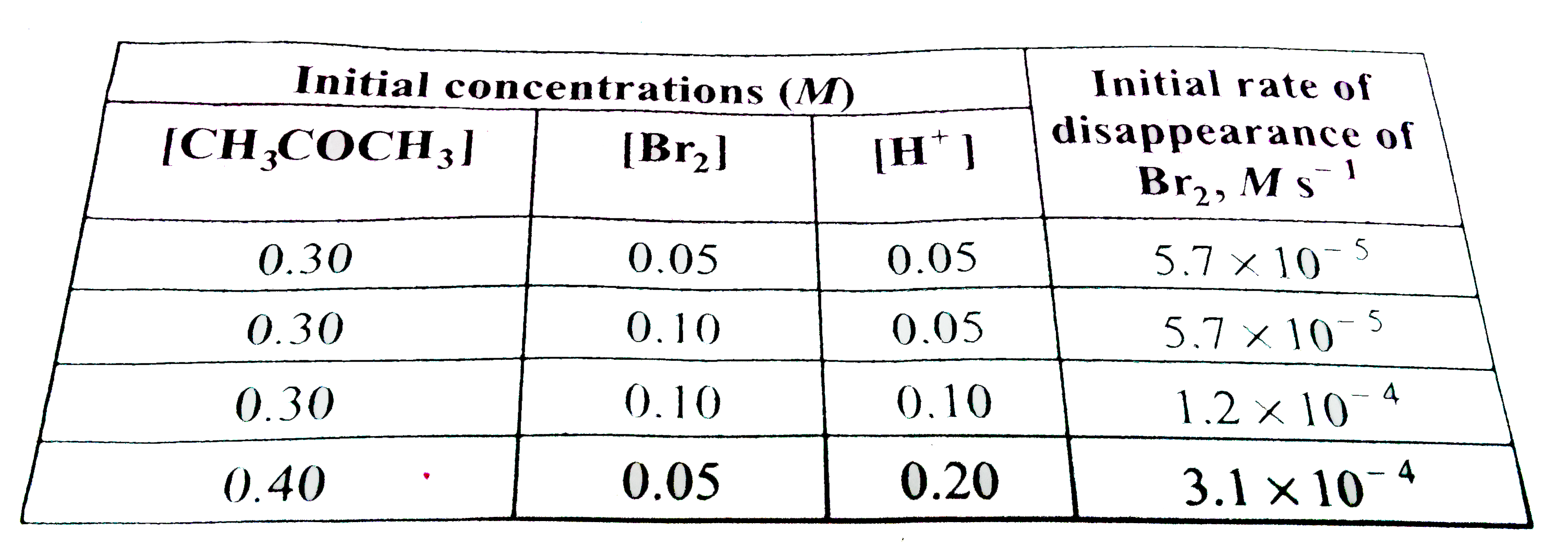The bromination of acetone that occurs in acid solution is represented by this equation
These kinetic data were obtained for given reaction concentrations.

Based on these data, the rate equation is
rate
rate =
rate =
rate
…(1)
…(2)
Form (1) and (2), y = 0 a.3. When the conc. Of is doubled, the intital rate fo disappearence of remains constant.
Hence order of reaction with respect to is zero. Thus the problabel rate law will be
Topper's Solved these Questions
Similar Questions
The bromination of acetone that occurs in acid solution is represented by this equation.
CH3COCH3(aq)+Br2(aq)→
CH3COCH2Br(aq)+H+(aq)+Br(aq)
These kinetic data were obtained for given reaction concentrations.
Initial concentration, M
[CH2COCH3][Br2][H+](Initail rate) (disappearance of Br2)0.300.050.055.7×10−50.300.100.055.7×10−50.300.100.101.2×10−40.400.50.203.1×10−4
View SolutionThe bromination of acetone that occurs in acid solution is represented by
CH3COCH3(aq.)+Br2(aq.)→CH3COCH2Br(aq.)+H+(aq.)+Br−(aq.)
These kinetic data were obtained for given reaction concentration
Initial concentration
Initial concentrationInitial rate ofdisappearance[CH3COCH3][Br2][H+]of Br20.300.050.055.0×10−50.300.100.55.0×10−50.300.100.101.0×10−40.900.050.103.0×10−4
Based on these data, order of reaction will be -
View Solution
Knowledge Check
The bromination of acetone that occurs in acid solution is represented by
CH3COCH3(aq.)+Br2(aq.)→CH3COCH2Br(aq.)+H+(aq.)+Br−(aq.)
These kinetic data were obtained for given reaction concentrations :

Based on these data, rate equations is :ARate=k[CH3COCH3][Br2][H+]2BRate=k[CH3COCH3][Br2][H+]CRate=k[CH3COCH3[H+]DRate=k[CH3COCH3[Br2]The bromination of acetone that occurs in acid solution is represented by this equation
CH3COCH3(aq)+Br2(aq)→CH3COCH2Br(aq)+H+(aq)+Br−(aq)
These kinetic data were obtained for given reaction concentrations .Initial concentrations , M
[CH3COCH3][Br2][H+]0.300.050.050.300.100.050.300.100.100.400.050.20
Initial rate , disappearance of Br2,Ms−1A5.7×10−5B5.7×10−5C1.2×10−4D3.1×10−4The bromination of acetone that occurs in acid solution is represented by this equation.
CH3COCH3(aq)+Br2(aq)→
CH3COCH2Br(aq)+H+(aq)+Br(aq)
These kinetic data were obtained for given reaction concentrations.
Initial concentration, M
[CH2COCH3][Br2][H+](Initail rate) (disappearance of Br2)0.300.050.051.5×10−50.300.100.055.7×10−50.300.100.101.2×10−40.400.50.203.1×10−4Arate =k[CH3COCH3][Br2]Brate =k[CH3COCH3][Br2][H+]2Crate =k[CH3COCH3][Br2][H+]Drate =k[CH3COCH3][H+]
Write the equilibrium constant expressions for the following reactions.
CH3COOH(aq)+H2O(l)⇔CH3COO−(aq)+H3O+(aq)
View SolutionThe bromination of acetone that occurs in acid solution is represented by
CH3COCH3(aq.)+Br2(aq.)→CH3COCH2Br(aq.)+H+(aq.)+Br−(aq.)
These kinetic data were obtained for given reaction concentrations :

Based on these data, rate equations is :
View SolutionThe bromination of acetone which occurs in acid solution is represented by the equation:
CH3COCH3(aq)+Br2(aq)→CH3COCH2Br(aq)+H+(aq)+Br−1(aq)
The following kinetic data was obtained for the given reaction concentration:

Initial rates of disappearance of of Br2(Ms−1
5.7×10−5,5.7×10−5
1.2×10−4,3.1×10−4
Based on these data, the rate equation is:
View SolutionThe bromination of acetone that occurs in acid solution is represented by this equation.
CH3COCH3(aq)+Br2(aq)→CH3COCH2Br(aq)+H+(aq)+Br−(aq)
These kinetic data were obtained for given reaction concentrations.
[CH3COCH3][Br2][H+]rate of disappearance of Br2,(Ms−1) 0.300.050.05 5.7×10−5 0.300.100.05 5.7×10−5 0.300.100.10 1.2×10−4 0.400.050.20 3.1×10−4
Based on these data, the rate equation is
View SolutionFor the elementary step
(CH3)3CBr(aq)→(CH3)3C+(aq)+Br−(aq)
the molecularity is
View Solution
